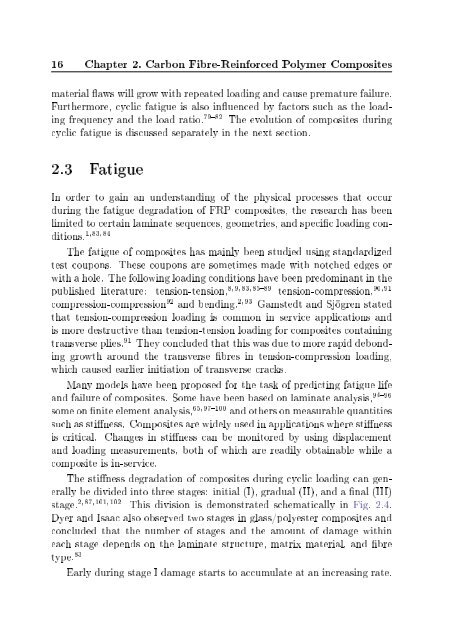Acoustic Emission Monitoring of CFRP Laminated Composites ...
Acoustic Emission Monitoring of CFRP Laminated Composites ...
Acoustic Emission Monitoring of CFRP Laminated Composites ...
Create successful ePaper yourself
Turn your PDF publications into a flip-book with our unique Google optimized e-Paper software.
16 Chapter 2. Carbon Fibre-Reinforced Polymer <strong>Composites</strong><br />
material aws will grow with repeated loading and cause premature failure.<br />
Furthermore, cyclic fatigue is also inuenced by factors such as the loading<br />
frequency and the load ratio. 7982<br />
The evolution <strong>of</strong> composites during<br />
cyclic fatigue is discussed separately in the next section.<br />
2.3 Fatigue<br />
In order to gain an understanding <strong>of</strong> the physical processes that occur<br />
during the fatigue degradation <strong>of</strong> FRP composites, the research has been<br />
limited to certain laminate sequences, geometries, and specic loading con-<br />
1, 83, 84<br />
ditions.<br />
The fatigue <strong>of</strong> composites has mainly been studied using standardized<br />
test coupons. These coupons are sometimes made with notched edges or<br />
with a hole. The following loading conditions have been predominant in the<br />
published literature: tension-tension, 8, 9, 83, 8589 90, 91<br />
tension-compression,<br />
compression-compression 92 and bending. 2, 93 Gamstedt and Sjögren stated<br />
that tension-compression loading is common in service applications and<br />
is more destructive than tension-tension loading for composites containing<br />
transverse plies. 91<br />
They concluded that this was due to more rapid debonding<br />
growth around the transverse bres in tension-compression loading,<br />
which caused earlier initiation <strong>of</strong> transverse cracks.<br />
Many models have been proposed for the task <strong>of</strong> predicting fatigue life<br />
and failure <strong>of</strong> composites. Some have been based on laminate analysis, 9496<br />
some on nite element analysis, 65, 97100 and others on measurable quantities<br />
such as stiness. <strong>Composites</strong> are widely used in applications where stiness<br />
is critical. Changes in stiness can be monitored by using displacement<br />
and loading measurements, both <strong>of</strong> which are readily obtainable while a<br />
composite is in-service.<br />
The stiness degradation <strong>of</strong> composites during cyclic loading can generally<br />
be divided into three stages: initial (I), gradual (II), and a nal (III)<br />
stage. 2, 87, 101, 102 This division is demonstrated schematically in Fig. 2.4.<br />
Dyer and Isaac also observed two stages in glass/polyester composites and<br />
concluded that the number <strong>of</strong> stages and the amount <strong>of</strong> damage within<br />
each stage depends on the laminate structure, matrix material, and bre<br />
type. 83<br />
Early during stage I damage starts to accumulate at an increasing rate.

















